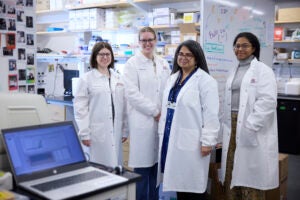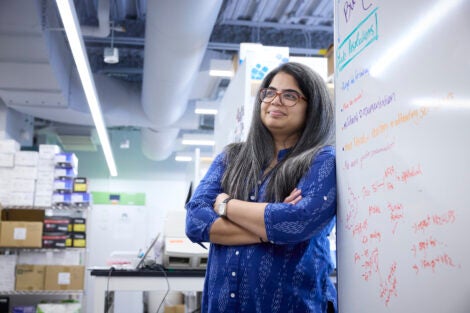February 21, 2024—Smita Gopinath, assistant professor of immunology and infectious diseases at Harvard T.H. Chan School of Public Health, discusses her path to managing her own lab, her research into an overlooked microbiome, and the “Red Queen Hypothesis.”
Q: Tell me about growing up and where your path to becoming a scientist began.
A: I always liked both literature and science; they fed different parts of me. But I grew up in Chennai, India, where you have to decide in high school what you want to study in college and what kind of career you want to pursue. I was really determined not to be forced into a choice that I didn’t want to make at that point. I had relatives in the United States who told me about the liberal arts system, so I applied to schools here and went to the place that gave me the most financial aid, which was Mount Holyoke College. I knew nothing about it when I went, and I loved every minute of it there. I got to double major in English and biology.
Q: How did you eventually make the choice between literature and science?
A: I applied to both English-related and science internships for the summer after my first year of college. The English ones were unpaid and the science ones were paid—enough that I could save money for plane tickets back to India. I ended up in an internship where we were in a lab rotating between different fields in biology—for example, we’d spend two weeks typing plants, two weeks quantifying bacteria on the surface of a blueberry. I liked all of it—I’m really a science generalist—and I liked being in the lab. I liked trying to find things out, trying to solve these ongoing puzzles. That was clearly my call to research. I also was lucky to work in the lab of a first-generation American professor who said to me, ‘This could be a whole career.’ I knew nothing about the American education system, didn’t know I could get paid to go to graduate school, didn’t know being a research scientist was a job. She was very formative in pointing me to my options.
Q: Now you have your own lab, based in the Department of Immunology and Infectious Diseases at Harvard Chan School. What are you researching?
A: Broadly, I want to understand how microbes affect our immunity and help protect us. More specifically, I’m focused on the mucosa, which is any part of your body that interacts with the environment and where three big actors—a pathogen, microbiome, and host immune response—have to meet and influence each other. I previously studied the microbiome of the gut—one of the largest mucosal surfaces—but lots of people were working on that. So, I thought about other surfaces and started researching the vaginal mucosa.

There has been a lot of amazing clinical profiling work showing that an abundance of a particular bacteria, lactobacilli, in the vaginal mucosa is closely correlated with better health outcomes. You’re less likely to acquire sexually transmitted infections, and if you have one, you’re less likely to transfer it. You have a reduced risk of preterm birth. We know these outcomes, but we don’t understand the actual biological mechanisms driving them. So that’s what my lab is researching. We are excited because we think we have identified one of the mechanisms.
We have a range of projects ongoing in the lab. For example, we have a project focusing on bacterial vaginosis (BV) and we just got pilot funding to look at pregnancy and preterm birth. Our bread and butter work the last three years has been around herpes. Hundreds of millions of people have herpes, but some of them may not even know while others have outbreaks five times a year. We think the vaginal microbiome might be playing a role in these differences.
Q: A concept underpinning your research is the Red Queen Hypothesis. Can you explain?
A: The Red Queen Hypothesis—evolutionary biologists love their literary references—comes from a scene in Alice in Wonderland, when they’re running but not moving forward. The Red Queen says they have to keep running to stay in the same place. The idea is that there’s constantly a fight between a pathogen and a host. As the host evolves and gets better defenses, the pathogen evolves and finds new ways to get around. Relevant to my lab, three systems—the pathogen, the mucosal response, and the lactobacilli—are all trying to compete. We recreate these interactions and manipulate each system to see how the others react. And then we can understand what equilibriums result.
Q: What are the potential applications of your research?
A: One of the things people are working hard on in the field is vaginal microbial transplants. We know that oral probiotics don’t work, and vaginal probiotics have some efficacy, but nowhere near total. So, there are researchers looking at what happens if you take vaginal fluid from healthy people and give it to people with, say, BV. Can you change the whole ecosystem? That’s kind of the top-down approach. Ours is bottom-up: We’re trying to understand what these bacteria do. If we identify things they make, and cells they affect, we can identify drug targets, pathways, and maybe even biologics.
Q: The vaginal microbiome field is newer and smaller than, for example, the gut microbiome field. Why do you think that is?
A: There are a couple of different answers to this but first, we do have to acknowledge that it’s very hard to get away from ingrained sexism and the patriarchy in terms of what problems we prioritize and what research we fund. Scientifically, we tend to ask questions and study what we experience and that’s why it is so important to have a diversity of backgrounds and experiences amongst scientists. The good news is that the vaginal microbiome field is growing very fast; Massachusetts General Hospital is currently conducting the world’s first randomized vaginal microbiome control trial. It’s an exciting time to be working in this field.
Q: Aside from the health applications, what keeps you passionate about your research?
A: The potential to help people is incredibly important and motivating, but there’s also just the interesting science. The more I learn about the vaginal microbiome, the more amazing it is. Diversity drives resilience in ecosystems. That’s not true in the vagina. This is a low-diversity ecosystem that is resilient. And it’s human-adapted and, unlike the gut microbiome, which depends on what you eat and where you live, it’s fairly consistent across people around the world. The vaginal microbiome is breaking a lot of rules—and should be sparking a lot of questions.
Quick hits with Smita Gopinath
- What are you currently reading? The Elemental Logic series by Laurie J. Marks
- What is your go-to piece of advice you give to your students? In scientific research, outcome is unlinked from effort. You will deal with disappointment a lot. Figure out what helps you bounce back.
- Where do you hope to travel next? I just got my green card a year and a half ago, so my husband and I finally get to think about traveling without worrying about getting stuck. Iceland and New Zealand are at the top of our list.
- What’s the last TV show you binge-watched? Bluey. My four-year-old is extremely into it.
- If you weren’t a scientist, what would you be? I’d want to own a bookshop.
- Who is your professional role model? From undergrad to now, I have been incredibly lucky in my mentors—all of them women, all of them intrinsically very different people, and all of them having taken different paths to science. It’s been helpful to see that there is no mold to fit.
- Where has been your favorite place to live? I’m an optimist—I’ll say where I live now, Jamaica Plain.
Photos by Kent Dayton
